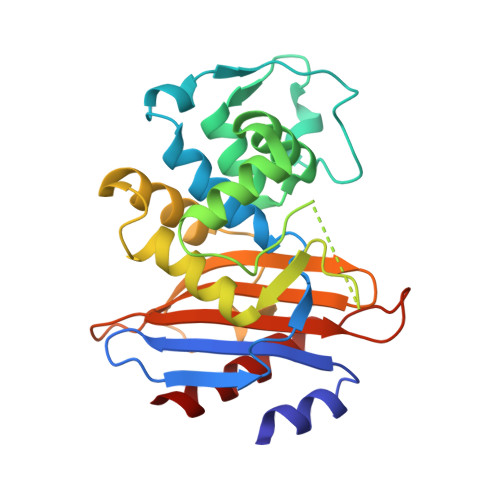Structural studies of the mechanism for biosensing antibiotics in a fluorescein-labeled beta-lactamase.
Wong, W.T., Au, H.W., Yap, H.K., Leung, Y.C., Wong, K.Y., Zhao, Y.(2011) BMC Struct Biol 11: 15-15
- PubMed: 21443768
- DOI: https://doi.org/10.1186/1472-6807-11-15
- Primary Citation of Related Structures:
3M2K - PubMed Abstract:
β-lactamase conjugated with environment-sensitive fluorescein molecule to residue 166 on the Ω-loop near its catalytic site is a highly effective biosensor for β-lactam antibiotics. Yet the molecular mechanism of such fluorescence-based biosensing is not well understood. Here we report the crystal structure of a Class A β-lactamase PenP from Bacillus licheniformis 749/C with fluorescein conjugated at residue 166 after E166C mutation, both in apo form (PenP-E166Cf) and in covalent complex form with cefotaxime (PenP-E166Cf-cefotaxime), to illustrate its biosensing mechanism. In the apo structure the fluorescein molecule partially occupies the antibiotic binding site and is highly dynamic. In the PenP-E166Cf-cefatoxime complex structure the binding and subsequent acylation of cefotaxime to PenP displaces fluorescein from its original location to avoid steric clash. Such displacement causes the well-folded Ω-loop to become fully flexible and the conjugated fluorescein molecule to relocate to a more solvent exposed environment, hence enhancing its fluorescence emission. Furthermore, the fully flexible Ω-loop enables the narrow-spectrum PenP enzyme to bind cefotaxime in a mode that resembles the extended-spectrum β-lactamase. Our structural studies indicate the biosensing mechanism of a fluorescein-labelled β-lactamase. Such findings confirm our previous proposal based on molecular modelling and provide useful information for the rational design of β-lactamase-based biosensor to detect the wide spectrum of β-lactam antibiotics. The observation of increased Ω-loop flexibility upon conjugation of fluorophore may have the potential to serve as a screening tool for novel β-lactamase inhibitors that target the Ω-loop and not the active site.
- Department of Applied Biology and Chemical Technology, Central Laboratory of Institute of Molecular Technology for Drug Discovery and Synthesis, The Hong Kong Polytechnic University, Hung Hom, Hong Hong, China.
Organizational Affiliation:

















